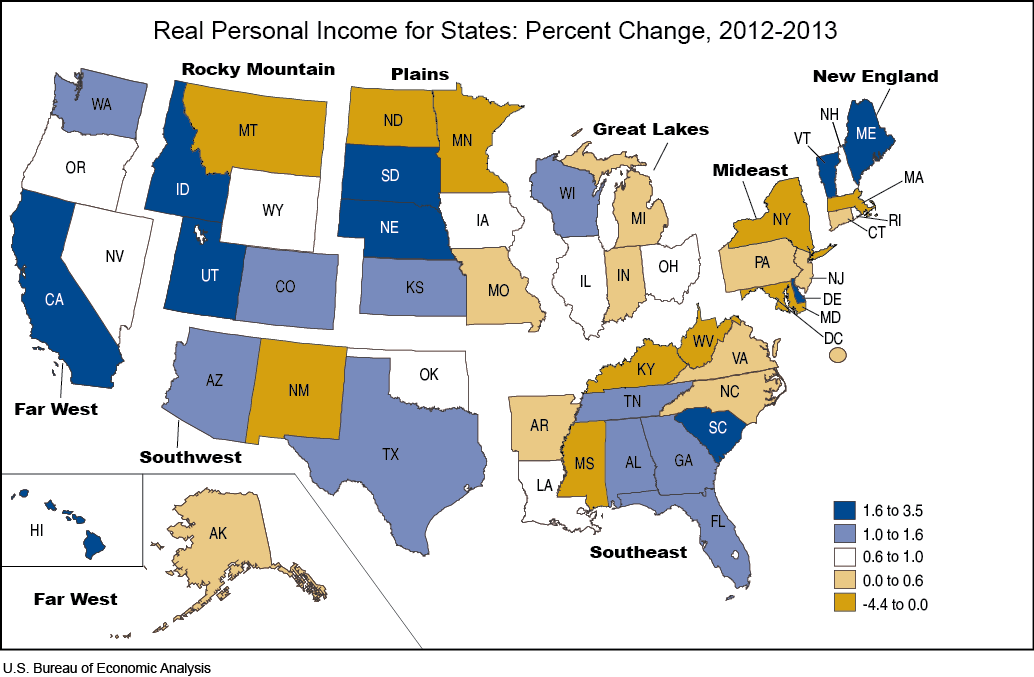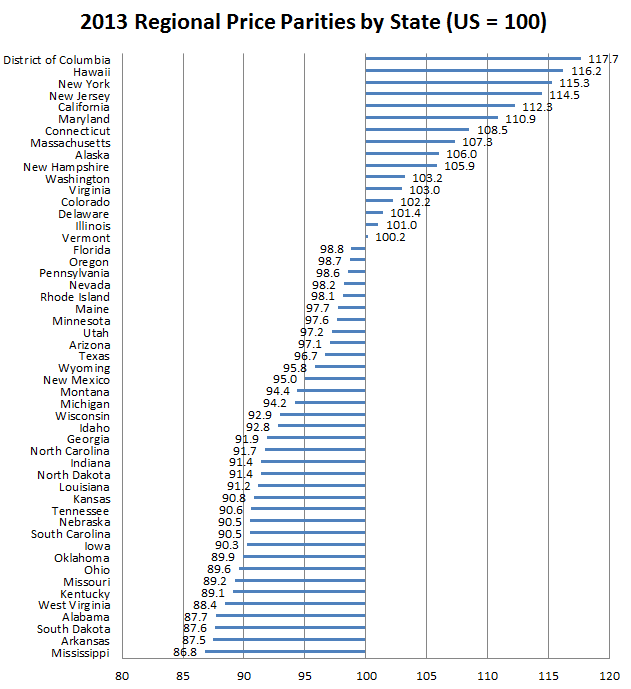News Release
Real Personal Income for States and Metropolitan Areas, 2013
Real personal income across all regions rose by an average of 0.8 percent in 2013. This growth rate reflects the year-over-year change in nominal personal income across all regions adjusted by the change in the national personal consumption expenditures (PCE) price index. On a nominal basis, personal income across all regions grew an average of 2.0 percent in 2013. In 2013, the U.S. PCE price index grew 1.2 percent.

Real Personal Income for States and Metropolitan Areas
Growth in real state personal income in 2013 ranged from an increase of 3.5 percent in Idaho to a decline of 4.4 percent in North Dakota. These growth rates reflect the year-over-year change in the state's nominal personal income, the change in the national PCE price index, and the change in the regional price parity for that state. After Idaho, the states with the largest growth rates were Utah (2.3 percent), California (2.2 percent), Nebraska (2.2 percent), and South Dakota (2.0 percent). After North Dakota, the states with the largest rates of decline were New Mexico (-0.6 percent), New York (-0.4 percent), Maryland (-0.3 percent), and Montana (-0.2 percent). States with growth rates close to the national average were Wyoming (0.8 percent), Oklahoma (0.7 percent), Ohio (0.7 percent), New Hampshire (0.7 percent), and Illinois (0.7 percent).
Growth in real metropolitan area personal income in 2013 ranged from an increase of 4.8 percent in Sioux City, IA-NE-SD to a decline of 3.1 percent in New Bern, NC. After Sioux City, IA-NE-SD, the metropolitan areas with the largest growth rates were Janesville-Beloit, WI (4.6 percent), Danville, IL (4.4 percent), Monroe, MI (4.4 percent), and Boise City, ID (3.9 percent). After New Bern, NC, the metropolitan areas with the largest declines were Beckley, WV (-3.0 percent), Fairbanks, AK (-2.9 percent), Peoria, IL (-2.9 percent), and Anniston-Oxford-Jacksonville, AL (-2.4 percent).
Regional Price Parities
Regional Price Parities (RPPs) measure the differences in the price levels of goods and services across states and metropolitan areas for a given year. RPPs are expressed as a percentage of the overall national price level for each year, which is equal to 100.0.
In 2013, the District of Columbia's RPP (117.7) was higher than that of any state. The states with the highest RPPs were Hawaii (116.2), New York (115.3), New Jersey (114.5), and California (112.3). Mississippi (86.8), Arkansas (87.5), South Dakota (87.6), Alabama (87.7), and West Virginia (88.4) had the lowest RPPs among the States. States with high (low) RPPs typically have relatively high (low) price levels for rents. States with RPPs closest to the national average price level were Vermont (100.2), Illinois (101.0), Florida (98.8), and Oregon (98.7).
In 2013, the metropolitan area with the highest RPP was Urban Honolulu, HI (122.5). Metropolitan areas with RPPs above 120.0 also included New York-Newark-Jersey City, NY-NJ-PA (122.3), San Jose-Sunnyvale-Santa Clara, CA (121.3), Bridgeport-Stamford-Norwalk, CT (120.8), Santa Cruz-Watsonville, CA (120.5), and San Francisco-Oakland-Hayward, CA (120.3). The metropolitan area with the lowest RPP was Beckley, WV (78.0), followed by Danville, IL (79.2), Rome, GA (81.3), Jonesboro, AR (81.7), and Valdosta, GA (81.8).

Technical Note on Regional Price Parities and Implicit Regional Price Deflators
Price indexes commonly measure price changes over time. The BEA's Personal Consumption Expenditure price index and the BLS' Consumer Price Index (CPI) are two examples. Spatial price indexes measure price level differences across regions for one time period. An example of these type of indexes are purchasing power parities (PPPs), which measure differences in price levels across countries for a given period, and can be used to convert estimates of per capita GDP into comparable levels in a common currency. The regional price parities (RPPs) that BEA has developed compare regions within the United States, but without the need for currency conversion. An implicit regional price deflator (IRPD) can be derived by combining the RPPs and the PCE price index.
Regional Price Parities. The RPPs are calculated using price quotes for a wide array of items from the CPI, which are aggregated into broader expenditure categories (such as food, transportation, or education)1. Data on rents are obtained separately from the Census Bureau's American Community Survey (ACS). The expenditure weights for each category are constructed using CPI expenditure weights, BEA's Personal Consumption Expenditures, and ACS rents expenditures2.
The broader categories and the data on rents are combined with the expenditure weights using a multilateral aggregation method that expresses a region's price level relative to the US3.
For example, if the RPP for area A is 120 and for area B is 90, then on average, prices are 20 percent higher and 10 percent lower than the US average for A and B, respectively. If the Personal Income for area A is $12,000 and for area B is $9,000, then RPP-adjusted incomes are $10,000 ($12,000/1.20) and $10,000 ($9,000/0.90), respectively. In other words, the purchasing power of the two incomes is equivalent when adjusted by their respective RPPs.
Implicit Regional Price Deflator. The IRPD is a regional price index derived as the product of two terms: the regional price parity and the US PCE price index.
The implicit regional price deflator will equal current dollar personal income divided by real personal income in chained dollars. The growth rate or year-to-year change in the IRPDs is a measure of regional inflation4
Detailed information on the methodology used to estimate the RPPs may be found in the article, "Real Personal Income and Regional Price Parities for States and Metropolitan Areas, 2008-2012", in the June 2014 issue of the Survey of Current Business.
